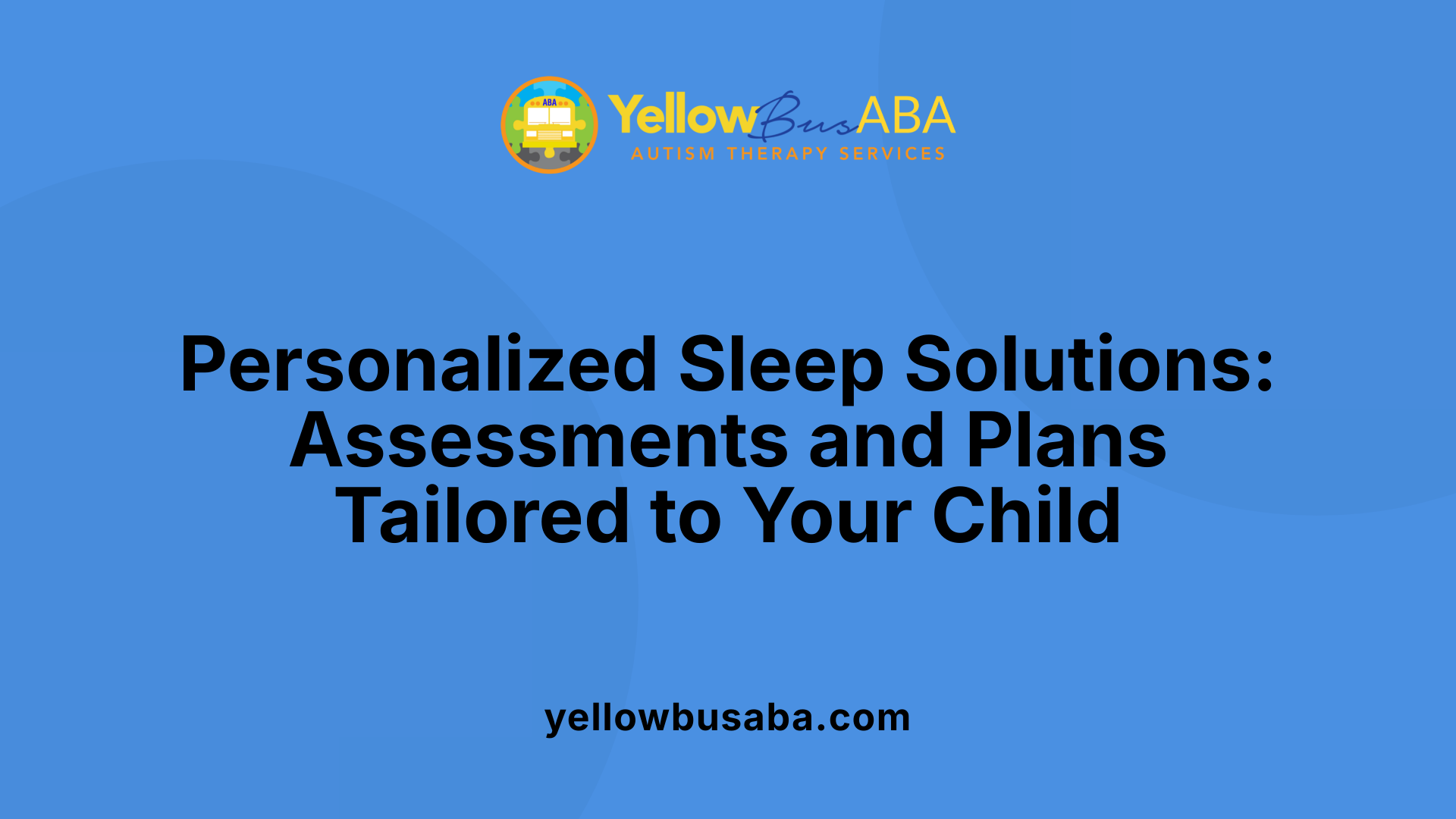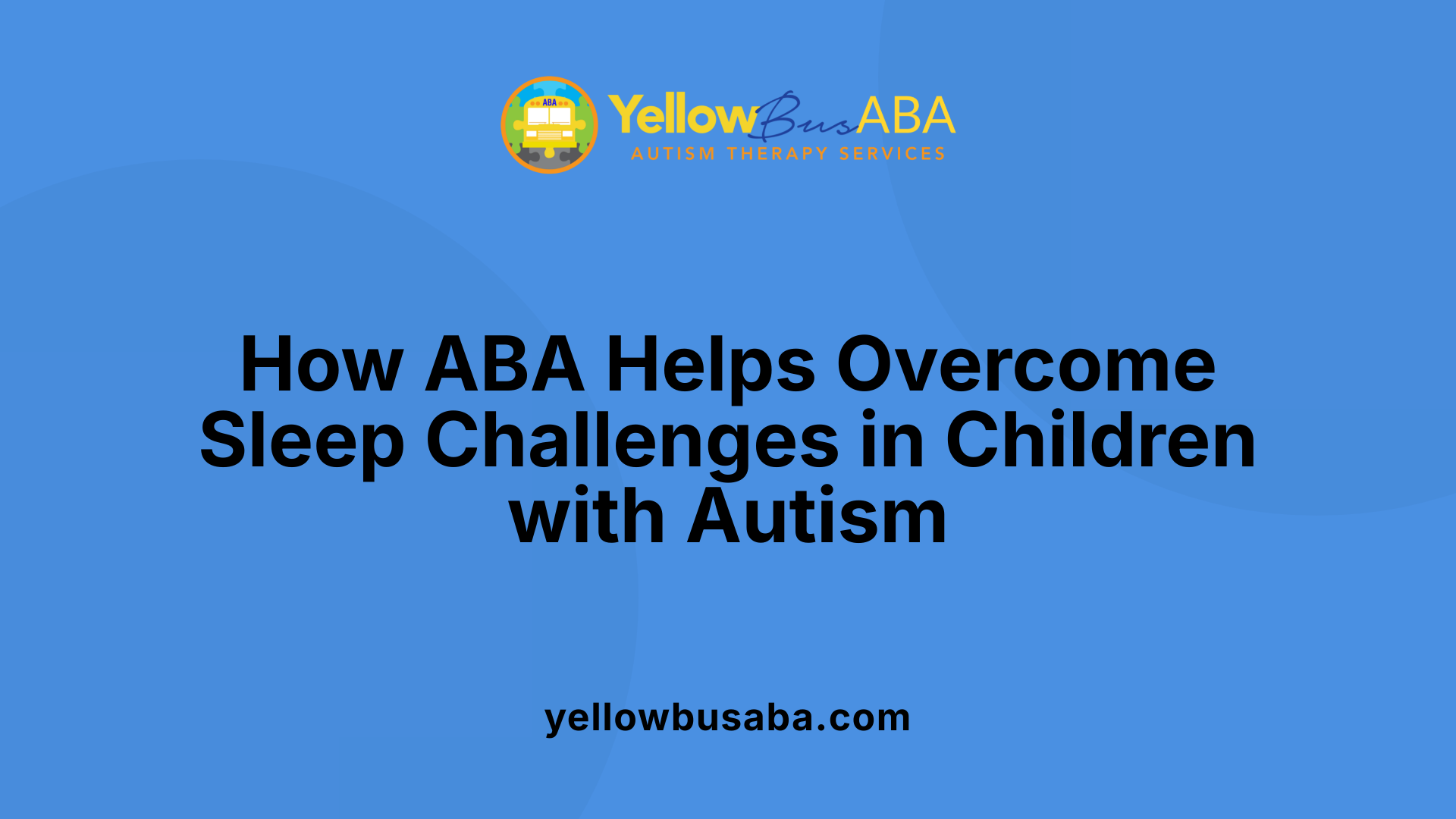Understanding the Role of ABA in Sleep Management
Sleep challenges are common among children with autism, often impacting their overall well-being, daytime behavior, and family dynamics. Applied Behavior Analysis (ABA) therapy emerges as an effective approach, particularly when administered at home, offering tailored strategies that address individual sleep issues and promote healthier sleep routines.
Customized Assessments and Tailored Sleep Plans
 To effectively address sleep difficulties in children with autism, ABA therapy begins with comprehensive assessments of sleep behaviors, routines, and environmental factors. These evaluations help identify specific challenges, such as sensory sensitivities or disruptive behaviors, that interfere with restful sleep.
To effectively address sleep difficulties in children with autism, ABA therapy begins with comprehensive assessments of sleep behaviors, routines, and environmental factors. These evaluations help identify specific challenges, such as sensory sensitivities or disruptive behaviors, that interfere with restful sleep.
Based on assessment results, individualized sleep plans are created. These plans incorporate strategies like establishing consistent bedtimes, structured routines, and environmental modifications—such as adjusting lighting, temperature, and reducing screen time—to promote a calm and conducive sleep environment.
Addressing sensory sensitivities is crucial. Children with autism may be overstimulated by certain textures, sounds, or lights, so the environment is tailored to minimize such stimuli. Behavioral techniques, including positive reinforcement and gradual shaping, are used to encourage adherence to healthy sleep routines.
ABA strategies are specifically customized to fit each child's unique needs. For example, some children might benefit from visual schedules or calming activities like tactile play or stretching before bed. Collaboration among healthcare professionals—such as sleep specialists and occupational therapists—ensures that the approach is comprehensive and effective.
Engaging parents and caregivers is vital. They are trained to implement consistent routines, monitor sleep patterns with tools like sleep trackers, and respond to the child's individual needs. This personalized approach often results in improved sleep quality, reduced family stress, and better daytime functioning for children.
In summary, tailored ABA interventions, grounded in detailed assessments and individualized plans, serve as a powerful method to improve sleep in children with autism, fostering healthier routines and emotional well-being.
| Assessment Focus | Intervention Elements | Additional Details |
|---|---|---|
| Sleep behaviors | Consistent routines | Visual schedules, calming activities |
| Routines | Environmental adjustments | Lighting, temperature, reduced screens |
| Sensory sensitivities | Reinforcement techniques | Tactile play, massage, relaxation exercises |
| Behavioral challenges | Parental involvement | Monitoring, reinforcement, gradual fading |
Effective A-B-A Techniques for Sleep Improvement

What techniques are involved in ABA therapy for improving sleep?
ABA therapy offers a structured approach to addressing sleep issues in children with autism. Central to this approach are establishing consistent bedtime routines that signal to the child it is time to sleep. These routines should be predictable and calming to help children transition smoothly from wakefulness to sleep.
Visual supports, such as picture schedules or visual timers, are often used to help children understand and follow bedtime steps. This visual aid decreases resistance and increases compliance by making routines more tangible.
Relaxation techniques play a crucial role. Deep breathing exercises, gentle stretches, calming music, or tactile activities like massage can relax the child's body and mind. These methods prepare the child physically and psychologically for sleep.
Gradual fading of parental presence is another effective strategy. Starting with a parent in the room until the child falls asleep, then slowly reducing the presence over sessions, fosters independence without causing anxiety.
Positive reinforcement is frequently used to encourage and reward desirable sleep behaviors, such as staying in bed or calming down at bedtime.
Environmental adjustments are also important. Managing sensory inputs — like adjusting lighting, regulating room temperature, or using tools such as weighted blankets — can create a sleep-conducive environment. For children with sensory sensitivities, these modifications can significantly reduce discomfort and facilitate better sleep.
In summary, ABA techniques for improving sleep are comprehensive. They include routines, visual supports, relaxation methods, environmental modifications, and behavioral reinforcement. All strategies aim to teach sleep skills, reduce anxieties, and promote consistent, restful sleep patterns for children with autism.
Benefits of At-Home ABA Therapy for Sleep Challenges

What are the benefits of at-home ABA therapy in addressing sleep issues in children with autism?
At-home ABA therapy offers a personalized approach that targets sleep difficulties in children with autism. By conducting thorough assessments, therapists create individualized plans tailored to each child's unique sleep behaviors, routines, and environmental factors.
This therapy emphasizes the development of consistent sleep routines, such as establishing calming pre-sleep activities and visual supports to signal bedtime. These routines help children recognize sleep cues and foster independence in falling asleep.
Environmental adjustments, like controlling lighting, temperature, and reducing screen exposure, are made to create a sensory-friendly sleep environment. Addressing sensory sensitivities can significantly improve sleep quality.
Positive reinforcement plays a vital role in encouraging healthy sleep behaviors, rewarding children for successful routines and independent sleep efforts.
Additionally, continuous data collection allows therapists to monitor progress and make timely adjustments to interventions, ensuring effectiveness over time.
Overall, at-home ABA therapy can lead to better sleep patterns, lessen family stress, and support improved functioning during the day, making a meaningful difference in the lives of children with autism and their families.
Strategies and Environmental Adjustments for Better Sleep

Establishing Calming Bedtime Routines, Including Tactile Play and Breathing Exercises
Creating a consistent, soothing bedtime routine is essential in helping children with autism transition to sleep smoothly. Activities like tactile play with soft toys, gentle stretching, massage, or breathing exercises signal the body that it is time to relax. These calming activities should start at least an hour before bed to help reduce overstimulation and promote a peaceful state of mind.
Visual supports, such as picture schedules or visual timers, aid children in understanding the routine and reduce anxiety. Over time, this predictability strengthens their sense of security and helps establish healthy sleep habits.
Adjusting Environmental Factors Like Lighting and Temperature
A sleep-conducive environment significantly impacts sleep quality. Keeping the room dark, using blackout curtains if necessary, helps signal to the brain that it’s time for sleep. Maintaining a consistent, comfortable temperature—ideally between 65-70°F (18-21°C)—prevents discomfort that can disrupt sleep.
For children with sensory sensitivities, minimizing noise or using white noise machines can create a calming auditory backdrop. Reducing harsh lighting and avoiding screens close to bedtime further supports natural melatonin production, enhancing sleep onset.
Reducing Stimulating Activities and Screen Time Before Bed
Limiting engaging activities and screen use at least an hour before bedtime helps prevent overstimulation. Screens emit blue light, which can interfere with sleep signals in the brain.
Instead, engaging in tactile play, reading, or quiet movement prepares a child for rest. Incorporating calming sensory experiences, such as gentle massage or stretching, helps soothe the nervous system.
Making Transitional Changes During Intensive ABA Periods, Such as Earlier Bedtimes
During intensive ABA therapy periods or big developmental leaps, children may experience sleep disruptions or become overstimulated. In these times, it may be helpful to make transitional changes, like moving bedtime earlier to prevent exhaustion.
Gradual adjustments—shifting bedtime by 15-minute intervals over several days—can help children accept the new schedule without resistance. Establishing a predictable wind-down routine and environmental adjustments supports these transitions.
| Strategy | Implementation Details | Expected Outcome |
|---|---|---|
| Consistent Bedtime Routine | Calming activities, visual supports, 1 hour before sleep | Reduced anxiety, quicker sleep onset |
| Environmental Optimization | Dark room, comfortable temperature, reduced noise, no screens | Improved sleep quality, easier to fall asleep |
| Limiting Stimulating Activities | No screens, quiet play, tactile activities before bed | Less overstimulation, better sleep maintenance |
| Transitional Schedule Adjustments | Earlier bedtime, gradual shifts, routine consistency | Better acceptance of sleep schedule, fewer night awakenings |
By implementing these strategies within at-home ABA therapy, children with autism can develop more predictable and calming sleep routines, leading to improvements in sleep quality, reduced family stress, and enhanced daytime behaviors.
Understanding the Connection Between ABA and Sleep Challenges
 ABA therapy plays an important role in addressing sleep difficulties faced by children with autism. It targets problematic behaviors such as resistance to bedtime, frequent night waking, or difficulty settling, which often interfere with restful sleep.
ABA therapy plays an important role in addressing sleep difficulties faced by children with autism. It targets problematic behaviors such as resistance to bedtime, frequent night waking, or difficulty settling, which often interfere with restful sleep.
One of the core strategies involves establishing visual supports, like picture schedules or calming images, to create predictability around bedtime routines. These visual cues reinforce what to expect, helping children feel more secure and less anxious about going to sleep.
Behavioral techniques such as desensitization help children gradually become more comfortable with their sleep environment, especially if they have sensory sensitivities. Gradual extinction or sleep training methods teach children to self-soothe, reducing reliance on parental intervention.
Adapting these strategies to each child's sensory sensitivities and developmental stage is vital. For example, modifying lighting, reducing noise, or using tactile comfort objects can make the sleep environment more conducive.
Parent involvement is crucial, and working closely with healthcare professionals allows for tailored sleep plans. These plans incorporate positive reinforcement, structured routines, and consistent timing to promote better sleep habits.
Overall, ABA therapy helps improve sleep quality by promoting routines and behaviors that encourage relaxation and self-regulation. Improved sleep not only benefits the child's health and development but also reduces family stress and enhances daytime functioning.
Promoting Long-Term Sleep Success and Family Well-Being

How does ABA therapy help improve sleep routines for children with autism?
ABA (Applied Behavioral Analysis) therapy plays a significant role in enhancing sleep routines for children with autism. It does this by teaching children appropriate sleep behaviors through evidence-based techniques such as stimulus control, bedtime fading, and positive reinforcement.
Therapists create consistent, calming bedtime routines that incorporate visual aids and soothing environmental adjustments to reduce resistance and anxiety. For example, establishing a structured wind-down period with tactile play, relaxation exercises, or calming music signals to the child that bedtime is approaching.
Parent involvement is crucial. Interventions often include gradually reducing parental presence in the child's room—fading out to promote independence—while maintaining a supportive and predictable environment.
ABA addresses behavioral challenges like night awakenings or difficulty settling down by reinforcing desirable sleep behaviors and implementing individualized plans tailored to each child's needs.
Overall, ABA therapy helps establish healthy sleep patterns, decreases sleep disturbances, and positively impacts daytime behavior, emotional regulation, and family functioning.
Stepping Toward Restful Nights and Bright Days
The integration of rigorous assessment, personalized strategies, and consistent implementation within at-home ABA therapy can transform sleep routines for children with autism. This approach not only fosters better sleep hygiene but also contributes significantly to behavioral stability, emotional well-being, and overall family harmony. As families collaborate closely with ABA professionals, they pave the way for calmer nights and energized days, underscoring the powerful impact of tailored behavioral interventions in managing sleep challenges effectively.
References
- Why ABA Therapy is Effective for Addressing Sleep Challenges in ...
- Bedtime Routines - Achievements ABA Therapy
- Can't sleep? ABA therapy can help! - The Behavior Exchange
- ABA Therapy and Sleep - Melissa Doman Sleep Consulting
- Promoting Sleep: ABA Techniques for Better Bedtimes
- Interventions | Center for Sleep in Autism Spectrum Disorder
- ABA Therapy for Kids with Sleep Challenges - ABATherapistJobs.com



.jpg)

.avif)
